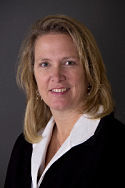AOTA member spotlight: Mary Walsh-Sterup, OTR/L, CHT
Mary Walsh-Sterup, OTR/L, CHT, is an Occupational Therapist and Partner at Central Nebraska Rehab Services. She spoke to Jamar Haggans, MS, OTR/L, Director of Quality at AOTA about her current position and how she became interested in quality.

Jamar Haggans: What is your current position?
Mary Walsh-Sterup: I'm a Partner at Central Nebraska Rehab Services, where I oversee quality and compliance. We have 15 outpatient clinics, contract hospitals, school districts, and skilled nursing. Our general philosophy is that if somebody needs services in Nebraska, we aim to make sure they can get services in their own community.
I'm an occupational therapist (OT) and certified hand therapist (CHT) by trade, but my day-to-day role involves more oversight, contracting, quality, billing, and negotiations with insurance companies.
Jamar Haggans: How did you become interested in quality?
Mary Walsh-Sterup: I became interested in quality around the time occupational therapy practitioners (OTPs) were allowed to participate in Physician Quality Reporting System (PQRS) (The Medicare Access and CHIP Reauthorization Act of 2015 replaced PQRS with the Quality Payment Program). Part of PQRS was having an outcome measure so when that was implemented, we really started paying close attention to our outcomes and what measures we were using. That is how I became involved in it from an OT standpoint and for our whole company.
Jamar Haggans: How has your interest in quality influenced what you do now?
Mary Walsh-Sterup: Learning more about quality helped me guide our teams to really take a deep dive into outcomes that drive our patients’ success. In small communities, our outcomes are our best marketing tool. When our patients are successful, they tell their physician. Physicians want patients to have great outcomes and love their therapy; that makes the physicians happy, which leads to more referrals. That’s truly what drives our business. We’re very interested in overall quality because it's in the best interest of the patient.
I’ve also used my knowledge in quality to work with my state’s Medicaid program, looking at outcomes and how we can best serve our Medicaid population.
Jamar Haggans: What advice would you give anyone else interested in quality?
Mary Walsh-Sterup: If possible, opt into the Medicare’s quality reporting program. There aren’t many OTs who are mandated to report MIPS, but there is an option to opt in and voluntarily report. I encourage practitioners to do this because it can change how you look at things and show how you compare nationally. It helps with documentation, and communicating the results can further help patients understand that they're truly making progress toward their goals.
Jamar Haggans: What can occupational therapy practitioners do to prepare for a future where quality is at the forefront of payment?
Mary Walsh-Sterup: Get involved in the quality reporting program in your setting. Another thing I would add is working to create additional quality and outcome measures that adequately describe what we do and show our outcomes.
Think about things that you can work on now to create outcome measures, to make it easier for reimbursement and documentation, because in the long run as we move towards a quality payment system, they're going to be needed.
Jamar Haggans: Is there anything else that you would like to add?
Mary Walsh-Sterup: Quality is going to be what drives payment and payment is what drives our future as therapists. To continue being a viable profession, financially, you need to start looking down stream at the quality of services you provide, which is going to lead to your reimbursement. It’s in the best interest of all our clients that we can continue to provide services to help them improve their engagement in meaningful occupations.